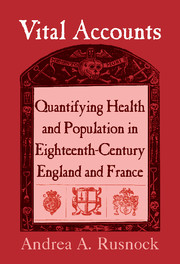Book contents
- Frontmatter
- Contents
- List of Illustrations
- Acknowledgments
- Vital Accounts
- Introduction
- 1 A New Science: Political Arithmetic
- PART ONE SMALLPOX INOCULATION AND MEDICAL ARITHMETIC
- PART TWO MEDICAL ARITHMETIC AND ENVIRONMENTAL MEDICINE
- PART THREE POLITICAL ARITHMETIC
- Conclusion
- Bibliography
- Index
- Titles in the series
Introduction
Published online by Cambridge University Press: 15 October 2009
- Frontmatter
- Contents
- List of Illustrations
- Acknowledgments
- Vital Accounts
- Introduction
- 1 A New Science: Political Arithmetic
- PART ONE SMALLPOX INOCULATION AND MEDICAL ARITHMETIC
- PART TWO MEDICAL ARITHMETIC AND ENVIRONMENTAL MEDICINE
- PART THREE POLITICAL ARITHMETIC
- Conclusion
- Bibliography
- Index
- Titles in the series
Summary
This book is about the activity of counting – specifically the counting of births and deaths – during the long eighteenth century. From the 1660s on, the numbers of born or dead, it was argued, would shed light on numerous political and medical issues. Yet despite this emerging desire for numbers, there were almost no government institutions, either at the national or local level, to collect and record these numbers. Rather, it was individuals from rural clergy to metropolitan physicians who did the counting. These political and medical arithmeticians, as they were called, invented ingenious methods of quantifying. They counted not just the number of christenings or burials in a specific geographic area but also, and often more importantly, different groups of individuals identified and classified by particular taxonomic schemes. These activities were as much about what to count as about how to count: The two were inextricable. Arithmeticians, in this way, brought quantitative analyses to bear on discussions of medical practice and therapy, salubrity and fecundity, and the growth or decline of population. Vital accounts – the numbers of dead and born – became, in short, the quantitative measure of public health and welfare.
Counting, Samuel Johnson told James Boswell in 1783, “brings everything to a certainty, which before floated in the mind indefinitely.” Johnson was not the only one to admire the bracing effects of counting.
- Type
- Chapter
- Information
- Vital AccountsQuantifying Health and Population in Eighteenth-Century England and France, pp. 1 - 14Publisher: Cambridge University PressPrint publication year: 2002



